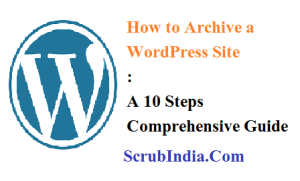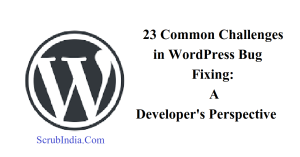Contents
How to Archive a WordPress Site: A 10 Steps Comprehensive Guide
Whether you’re a blogger, a business owner, or a web developer, there may come a time when you need to archive a WordPress site. WordPress is a powerful and popular content management system that allows users to create and manage websites with ease.
Archiving a site involves creating a backup of your website’s content, files, and databases for various reasons, such as safeguarding your data, moving to a new hosting provider, or preserving a historical record of your website’s content. In this post, we will explore the importance of archiving a WordPress site and provide a step-by-step guide on how to do it effectively.

Why Archive a WordPress Site?
Archiving a WordPress site is an essential process that offers several benefits. Let’s take a closer look at why you might consider archiving your WordPress site:
- Data Protection: Websites can be vulnerable to various threats, such as hacking, data loss, or server failures. By archiving your site, you ensure that you have a secure copy of your website’s content, ensuring data protection.
- Disaster Recovery: In the event of a catastrophic event or a website malfunction, having a recent backup will allow you to quickly restore your site to a previous state, minimizing downtime.
- Updates and Upgrades: Before making significant changes to your website, like updating themes, plugins, or the WordPress core, archiving the site provides a safety net. If anything goes wrong during the update process, you can easily roll back to the archived version.
- Migration: When you decide to change your hosting provider or domain name, archiving your site makes the migration process smoother and minimizes the risk of data loss.
- Historical Records: Some website owners may want to maintain a historical archive of their content for reference or auditing purposes. Archiving ensures that you have a record of your site’s content at various points in time.
- Legal Compliance: Depending on your industry and location, you may be required to retain historical records of your website. Archiving helps you comply with legal regulations.
Now that we understand the Importance of archiving a WordPress site
let’s delve into the steps to Archive a WordPress Site effectively.
Step 1: Choose the Right Backup Solution
To archive a WordPress site, you’ll need a reliable backup solution. There are various plugins and tools available that can simplify the backup process. Here are a few popular options:
- UpdraftPlus: UpdraftPlus is a user-friendly plugin that allows you to schedule automated backups of your site. It offers both free and premium versions with various features.
- BackupBuddy: BackupBuddy is a premium plugin that provides comprehensive backup and restoration options. It’s known for its reliability and ease of use.
- All-in-One WP Migration: This plugin is excellent for both backing up and migrating your site. It enables you to export your site’s data and import it elsewhere.
- cPanel: If you’re comfortable with server management, cPanel offers a manual way to create backups of your site’s files and databases.
Choose the backup solution that best suits your needs and budget.
Step 2: Install and Configure Your Backup Solution
Once you’ve chosen a backup solution, install and activate it on your WordPress site. Most backup plugins will guide you through the initial setup process, which typically involves configuring backup frequency, storage location, and other settings.
Ensure that your backup solution supports automated and scheduled backups, as regular backups are crucial for maintaining an up-to-date archive of your site.
Step 3: Schedule Regular Backups
To keep your archived WordPress site current, it’s essential to schedule regular backups. The frequency of backups depends on how frequently you update your website. If your site undergoes frequent changes, consider daily or weekly backups. If updates are less frequent, monthly backups may suffice.
Step 4: Perform a Full Backup
Before going to Archive a WordPress Site, perform a full backup, which includes all your site’s files and the database. Most backup solutions offer options for full backups, and it’s crucial to select this option to ensure that all your data is properly archived.
Step 5: Store Backups Safely
Where you store your backups is critical for the security of your archived WordPress site. There are several storage options to consider:
- Cloud Storage: Services like Google Drive, Dropbox, or Amazon S3 provide secure and easily accessible storage for your backups.
- On-site Storage: Storing backups on your web server is an option, but it’s not recommended because it won’t protect your data in case of server failure.
- Remote FTP: You can use FTP to transfer backups to a remote server or a different hosting provider for added security.
Remember to encrypt your backups, use strong passwords for cloud storage accounts, and follow best practices for securing your backup files.
Step 6: Verify Backup Integrity
After each backup, it’s essential to verify the integrity of your backup files. Most backup solutions include a verification process to ensure that your backups are complete and free from corruption.
Step 7: Test Restorations
Periodically, it’s a good practice to test your backup files by performing a restoration on a separate test server or a local environment. Testing restorations helps you ensure that your archived site is functioning correctly and that you can rely on it when needed.
Step 8: Maintain Documentation
Creating documentation detailing your backup process, including the backup schedule and locations, is essential for efficient archiving. Keep records of when and where backups were stored and any changes made to your backup process over time.
Step 9: Archive the Backup Files
Now that you have an efficient backup system in place, you can consider your site effectively archived. By adhering to regular backup schedules, testing restorations, and maintaining proper documentation, you ensure the integrity and accessibility of your archived WordPress site.
Step 10: Monitor and Update
Archiving your WordPress site is not a one-time task but an ongoing process. You must monitor your backup system regularly, ensuring that backups are being created, stored correctly, and remain accessible. As your website evolves, make any necessary adjustments to your archiving strategy to accommodate changes in your site’s structure and content.
Conclusion
Archive a WordPress Site is a crucial aspect of website management that provides data protection, disaster recovery, and historical record-keeping benefits. By following the steps outlined in this guide and utilizing a reliable backup solution, you can effectively archive your site and ensure that your valuable content and data are safeguarded.
Remember to choose the right backup solution, schedule regular backups, store backups safely, verify backup integrity, and test restorations periodically. Maintain proper documentation of your backup process and stay vigilant in monitoring and updating your archiving strategy to adapt to changes in your website’s needs.
In today’s digital age, where websites are central to businesses and personal projects, archiving your WordPress site is a responsible and necessary practice. With a robust archiving system in place, you can have peace of mind knowing that your website’s data is protected, and your online presence remains resilient in the face of potential threats and challenges. So, don’t wait – go to Archive a WordPress Site today and safeguard your digital assets for the future.

Friends, you have just read the post “ How to Archive a WordPress Site: A 10 Steps Comprehensive Guide“ we hope you will like this post.
If yes then share it with your friends and keep visiting our website for reading more such posts.
If you interested to read about Astrology & Hindu Religion : Click here
……………………………
Technological Tips
Also Read : Unleashing the Power of Content Monetization Platforms: A Comprehensive Guide with 5 major challenges
Also Read : How to Make Money from Social Media Marketing: 10 Proven Strategies
Health & Wellness
Also Read : Heavy Periods after Pregnancy: Causes, Symptoms, and Management are explained in detail
Also Read : Depression and Libido:Understanding the Impact of the Connection Between-5 complex links
Travel India
Also Read : Swaminarayan Akshardham Temple New Delhi- A Complete A to Z Tour Guide
you were reading * How to Archive a WordPress Site: A 10 Steps Comprehensive Guide*




